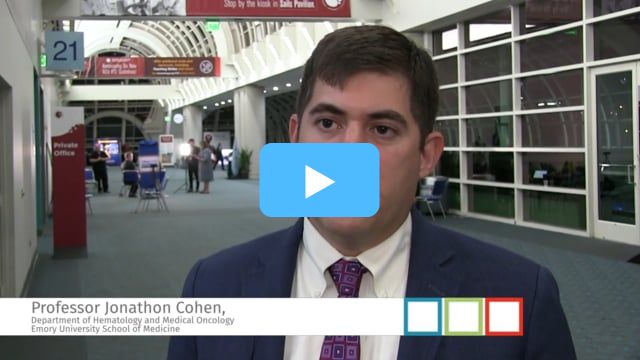Advertisment
ASH 2018: Novel agents in combination for relapsed/refractory Hodgkin’s lymphoma: the ECOG-ACRIN E4412 study

Article written by Maria Dalby. Interviews by Hannah Chatfield.
Immune checkpoints such as CTLA-4 and PD-1 are known to play a vital part in anti-tumour T-cell function in many different types of cancers1-4 and provide key targets for immunotherapy. By combining checkpoint inhibitor therapy with the CD30 antibody-drug conjugate brentuximab vedotin (BV) which exerts direct cytotoxic effects on the tumour cells and also is believed to promote immunogenic cell death and antibody-dependent cellular phagocytosis, it may be possible to turn the tumour microenvironment against the tumour and this way overcome tumour cell resistance in relapsed/refractory Hodgkin’s lymphoma (RRHL) which remains a significant unmet clinical need.
This was the rationale for E4412, a phase 1 study carried out within the ECOG-ACRIN Cancer Research Group in which patients with RRHL were treated with BV in combination with CTLA-4 blocker ipilimumab and PD-1 blocker nivolumab.
Immune checkpoints such as CTLA-4 and PD-1 are known to play a vital part in anti-tumour T-cell function in many different types of cancers1-4 and provide key targets for immunotherapy. By combining checkpoint inhibitor therapy with the CD30 antibody-drug conjugate brentuximab vedotin (BV) which exerts direct cytotoxic effects on the tumour cells and also is believed to promote immunogenic cell death and antibody-dependent cellular phagocytosis, it may be possible to turn the tumour microenvironment against the tumour and this way overcome tumour cell resistance in relapsed/refractory Hodgkin’s lymphoma (RRHL) which remains a significant unmet clinical need. This was the rationale for E4412, a phase 1 study carried out within the ECOG-ACRIN Cancer Research Group in which patients with RRHL were treated with BV in combination with CTLA-4 blocker ipilimumab and PD-1 blocker nivolumab.
The results of the first six cohorts, A-F, in the E4412 study were presented by Dr Fangxin Hong from the Dana Farber Cancer Institute (Boston, USA) in an oral abstract session on outcomes research in lymphoid malignancies (abstract 623). Patients in this part of the study received 16 cycles of BV plus either ipilimumab for up to one year (cohort A-C; n=23) or nivolumab for up to two years (cohort D-F; n=19). The safety analysis included seven symptomatic adverse events (fatigue, peripheral sensory neuropathy, nausea and vomiting, rash and skin events, diarrhoea, any type of ocular adverse event, and hair loss) as well as maximum-grade toxicity (ToxC analysis) and mean toxicity over up to 12 cycles (ToxT analysis). The rate of the selected symptomatic adverse events, of any grade, was higher in the cohorts receiving BV plus ipilimumab compared with those receiving BV plus nivolumab, approaching statistical significance for some events: fatigue 52% versus 26% (p=0.09); peripheral sensory neuropathy 61% versus 53%; nausea and vomiting 70% versus 53%; rash and skin events 65% versus 37% (p=0.07); diarrhoea 57% versus 21% (p=0.02); any type of ocular adverse event 17% versus 21%; and hair loss 17% versus 0% (p=0.06). The rate of Grade 3 symptomatic adverse events was similar for the two treatments. Patients on BV plus ipilimumab had significantly more Grade 3 or 4 events, and also more adverse events over time compared with patients on BV plus nivolumab.
Results from the remaining cohorts, G-I, in the E4412 study were presented by Dr Catherine Diefenbach from the New York University Cancer Center (New York, USA) who is also principal investigator on the study (abstract 679). Patients in these cohorts received triple therapy with BV, ipilimumab and nivolumab at two different BV dose levels (1.2mg/kg and 1.8mg/kg) and in an expansion cohort at the higher BV dose level. A total of 22 patients were included in these cohorts; the most common adverse events overall were diarrhoea, fatigue, nausea and peripheral sensory neuropathy, and the most common Grade 3 adverse events were fatigue, maculo-papular rash and vomiting. A total of 19 patients had evaluable responses with an ORR of 95% and a CR rate of 84% which was considerably higher than the responses seen in the cohorts receiving BV plus ipilimumab (ORR 76% and CR 57%) and BV plus nivolumab (ORR 88% and CR 66%). Median PFS and OS had not been reached. Phase 2 of the E4412 study is currently in the process of accruing patients; this phase will compare BV plus nivolumab with BV plus ipilimumab and nivolumab and will include long-term follow up.
References
- Brahmer JR, Drake CG, Wollner I, et al. Phase I study of single-agent anti-programmed death-1 (MDX-1106) in refractory solid tumors: safety, clinical activity, pharmacodynamics, and immunologic correlates. J Clin Oncol 2010;28:3167-75.
- Pardoll DM. The blockade of immune checkpoints in cancer immunotherapy. Nat Rev Cancer 2012;12:252-64.
- Wang C, Thudium KB, Han M, et al. In vitro characterization of the anti-PD-1 antibody nivolumab, BMS-936558, and in vivo toxicology in non-human primates. Cancer Immunol Res 2014;2:846-56.
- Hamanishi J, Mandai M, Iwasaki M, et al. Programmed cell death 1 ligand 1 and tumor-infiltrating CD8+ T lymphocytes are prognostic factors of human ovarian cancer. Proc Natl Acad Sci U S A 2007;104:3360-5.





